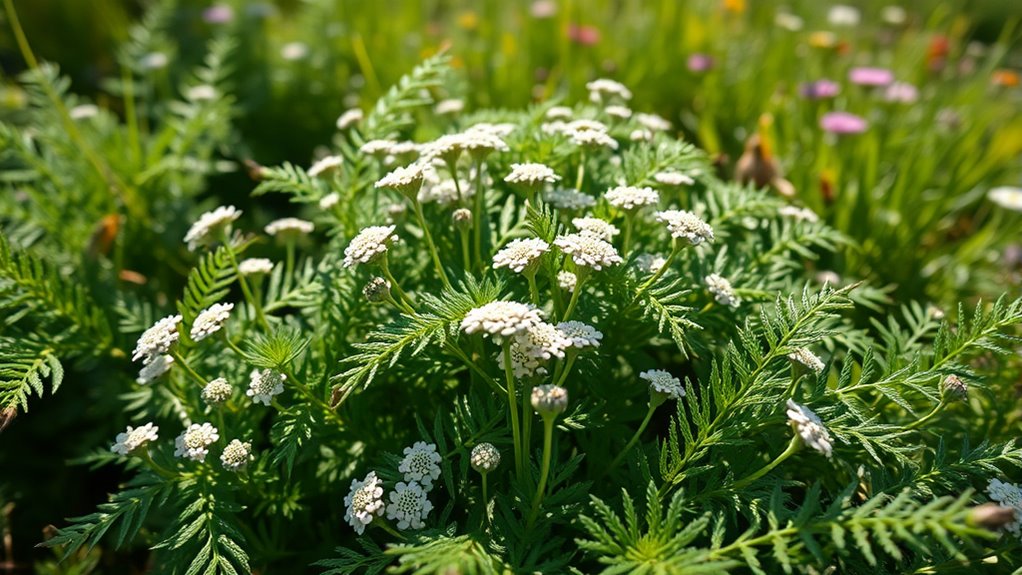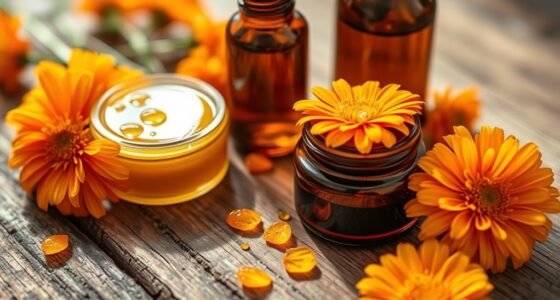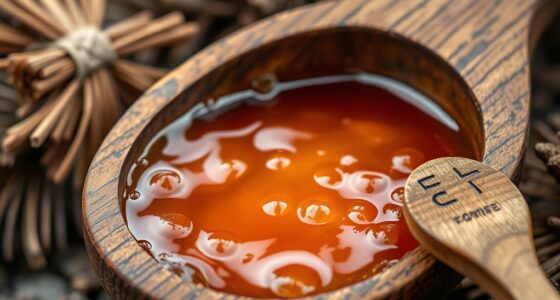Yarrow is a powerful field medicine for wound care. You can identify it by its fern-like, finely divided leaves and flat clusters of white or pink flowers that bloom in late spring and summer. To use it, harvest the leaves and flowers early in the day, crush them to release healing compounds, and apply directly to the wound. Proper preparation and caution guarantee safe, effective treatment—learn more about harnessing yarrow’s natural healing properties to assist you in emergency situations.
Key Takeaways
- Yarrow’s alkaloids constrict blood vessels, aiding rapid clotting and stopping bleeding in wounds.
- Harvest yarrow early in the day, using sharp tools, and dry in a well-ventilated area for maximum medicinal potency.
- Crush or grind fresh yarrow leaves to release active compounds, then apply directly to the wound for antimicrobial effects.
- Secure yarrow with a clean bandage and change dressings regularly to promote faster healing.
- Use yarrow externally for wound care and cautiously as a tea or tincture for internal ailments, considering potential allergies.
Recognizing and Harvesting Yarrow in the Wild
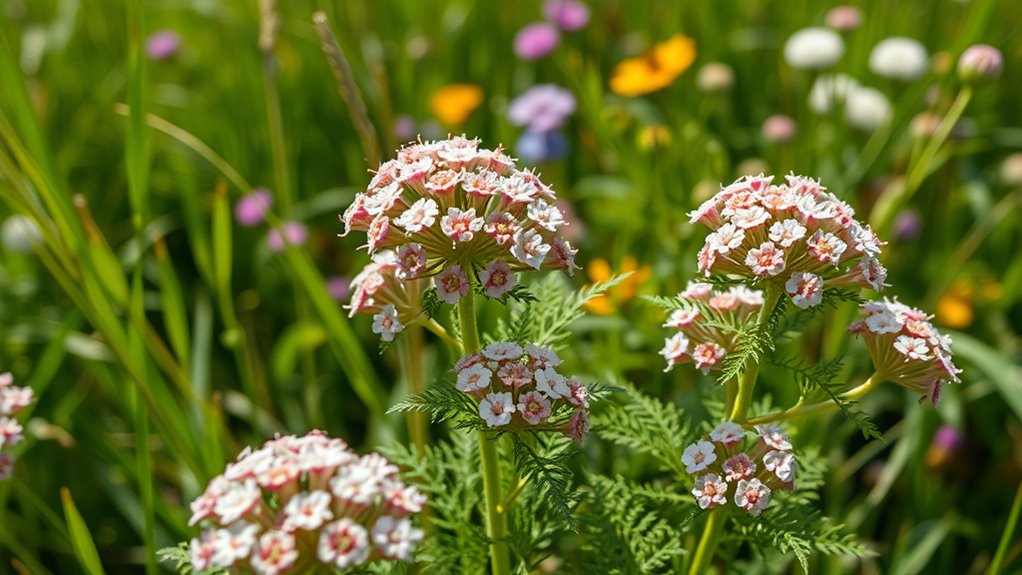
Have you ever wondered how to identify yarrow in the wild? Proper plant identification is key to harvesting yarrow safely and effectively. Look for its fern-like, finely divided leaves that have a distinctive aroma when crushed. The tall, sturdy stems typically reach up to three feet, topped with flat clusters of tiny white or pink flowers. Yarrow blooms from late spring to summer, making it easy to spot during these months. When harvesting, practice sustainable harvesting by cutting only a portion of the plant, leaving enough behind for regrowth and pollinators. Avoid taking plants from crowded or endangered areas, and always ensure you’re confident in your plant identification skills before harvesting. This approach guarantees you gather yarrow responsibly while preserving wild populations. Additionally, understanding how to identify native plants can help ensure you are harvesting from healthy, sustainable populations.
The Healing Properties That Make Yarrow a Natural Remedy
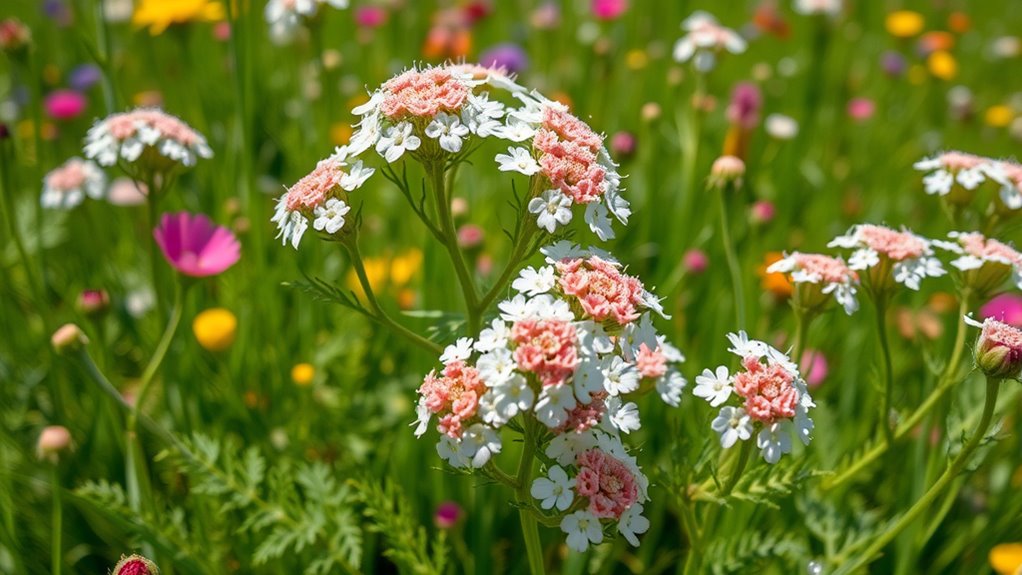
Yarrow’s remarkable healing properties have made it a valued natural remedy for centuries. In herbal traditions worldwide, it’s prized for its ability to stop bleeding, reduce inflammation, and promote tissue regeneration. These effects stem from its chemical properties, including compounds like alkaloids, flavonoids, and tannins. Alkaloids help constrict blood vessels, aiding in rapid clotting, while flavonoids and tannins possess anti-inflammatory and antimicrobial qualities. These natural components work together to accelerate wound healing and prevent infection. Additionally, the presence of chemical compounds in yarrow enhances its effectiveness as a healing agent. Yarrow’s versatility in traditional medicine highlights its effectiveness as a healing agent. Its chemical makeup not only supports physical recovery but also aligns with herbal practices that emphasize natural, plant-based remedies. This combination of herbal traditions and chemical properties makes yarrow a powerful, time-tested remedy for wound care.
Preparing Yarrow for Wound Treatment

Wondering how to prepare yarrow for wound treatment? Start by using proper foraging techniques to identify healthy, wild yarrow plants with feathery leaves and clusters of white flowers. When harvesting, use sharp scissors or pruning shears as your tools to avoid damaging the plant and to keep it clean. Harvest the leaves and flowers early in the day when the plant’s active compounds are most potent. Gently cut the stems, avoiding any damaged or wilted parts. Rinse the yarrow thoroughly with clean water to remove dirt and insects. To preserve its medicinal qualities, dry the plant in a well-ventilated area away from direct sunlight. Proper preparation guarantees you have effective yarrow for wound care when needed. Additionally, choosing the right drying method helps retain its active compounds, ensuring maximum efficacy during use.
Step-by-Step Guide to Applying Yarrow to Injuries
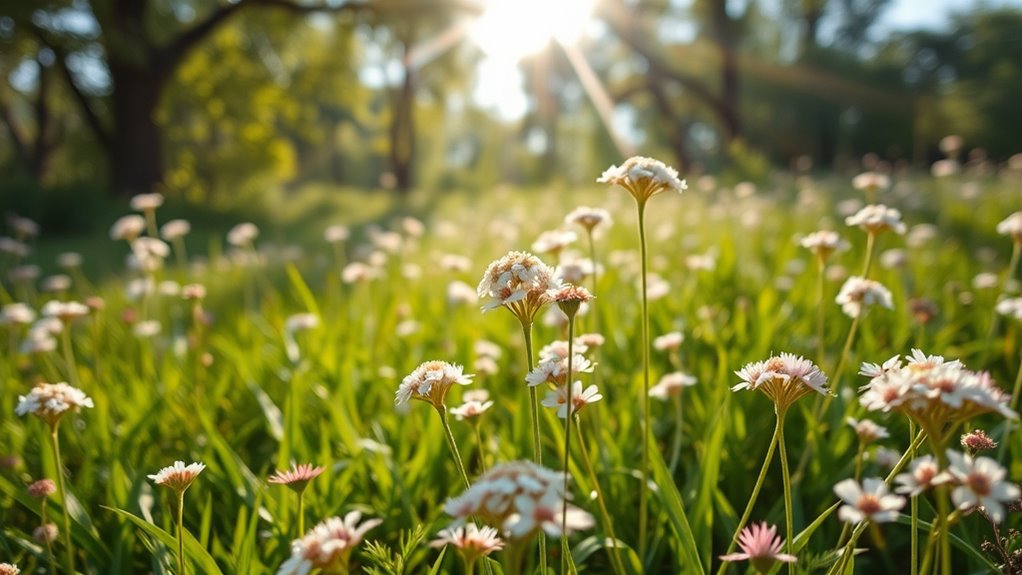
Once your yarrow is prepared and ready to use, applying it to an injury is straightforward. Start by cleaning the wound with water to remove dirt and debris. Next, crush or crush and grind the yarrow leaves to release their active compounds, highlighting yarrow’s antimicrobial effects. Gently place the prepared yarrow directly onto the wound, ensuring full coverage. If you’re using fresh yarrow, you can also create a poultice or compress. Apply a clean cloth or bandage over the yarrow to hold it in place and protect the area. Yarrow’s traditional uses include promoting clotting and preventing infection, so consistent application can support faster healing. Repeat the process as needed, changing the dressing regularly to keep the wound clean and aid recovery. Incorporating yarrow into your wound care routine aligns with its cultural history as a natural remedy for healing.
Additional Uses and Precautions When Using Yarrow
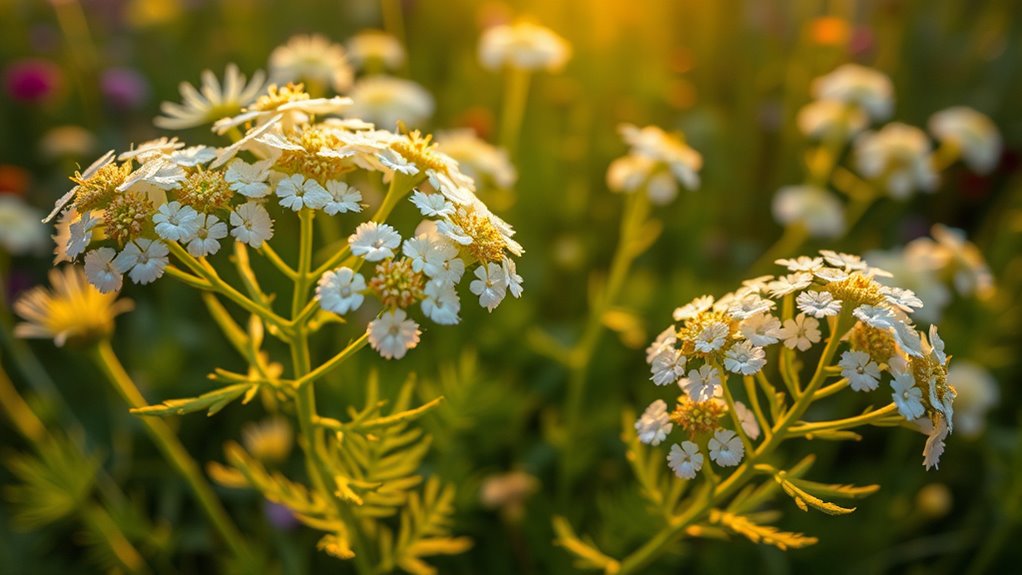
While yarrow offers valuable benefits for wound healing, it’s important to be aware of its additional uses and potential precautions. Yarrow can be used as a tea or tincture for colds, inflammation, or menstrual discomfort, but proper yarrow dosage is essential to avoid side effects. Typically, a tea is made with 1-2 teaspoons of dried yarrow per cup of boiling water, consumed 2-3 times daily. Be cautious of yarrow interactions, especially if you’re on blood-thinning medications or have allergies to plants in the Asteraceae family. Excessive use or high doses might cause allergic reactions or interfere with medications. Always consult a healthcare provider before using yarrow internally or in larger quantities, particularly if you’re pregnant, nursing, or taking other medications. Additionally, understanding essential oil safety can help prevent adverse reactions when using herbal remedies.
Frequently Asked Questions
Can Yarrow Be Used to Treat Internal Injuries or Only External Wounds?
You might wonder if yarrow can treat internal injuries or just external wounds. While yarrow is known for its herbal synergy in promoting external healing by stopping bleeding and reducing inflammation, it’s not typically used for internal injuries. Its benefits are primarily for external wound care. For internal healing, you should consult a healthcare professional, as other treatments are better suited for internal injuries.
Are There Any Known Allergic Reactions to Yarrow for Sensitive Individuals?
Imagine a gentle breeze brushing softly against your skin, yet for some, yarrow might stir a tiny, unwelcome flutter. If you’re sensitive, you could experience allergic dermatitis, a reaction that hints at skin sensitivity. While rare, some people do have allergic responses to yarrow, so it’s wise to test a small patch first. If irritation occurs, it’s best to stop use and seek guidance from a healthcare professional.
How Long Does Yarrow Remain Effective After Harvesting?
You wonder how long yarrow stays effective after harvesting. Its herbal preservation depends on proper storage techniques; if kept in a cool, dark, airtight container, yarrow can remain potent for up to a year. Exposure to air, light, or moisture reduces its effectiveness quickly. For best results, dry yarrow thoroughly before storage, ensuring it retains its medicinal properties for future use.
Is Yarrow Safe for Children or Pregnant Women to Use on Wounds?
Child safety and pregnancy considerations come first when using yarrow on wounds. You should exercise caution, as yarrow might cause allergic reactions or sensitivities in children and pregnant women. Consult a healthcare professional before applying yarrow, especially for sensitive populations. While yarrow has healing properties, it’s safest to avoid use without guidance, ensuring safety and avoiding any unintended side effects during pregnancy or with young children.
Can Yarrow Be Combined With Other Herbal Remedies for Enhanced Healing?
You can definitely explore herbal synergy by combining yarrow with other remedies to boost wound healing. Mixing yarrow with herbs like calendula or plantain enhances antimicrobial and anti-inflammatory effects, supporting faster recovery. Just verify you research each herb’s safety and compatibility, especially for children or pregnant women. When creating wound healing combinations, start with small amounts and monitor for any reactions to ensure safe, effective herbal synergy.
Conclusion
Yarrow has been a trusted natural remedy for centuries, thanks to its powerful healing properties. Did you know that yarrow can stop bleeding within minutes and promote faster healing? By learning to recognize, prepare, and apply yarrow correctly, you can effectively treat minor wounds in the wild. Keep in mind, always use caution and consult a professional for serious injuries. Embrace yarrow as your field medicine for a natural, effective first aid solution.

